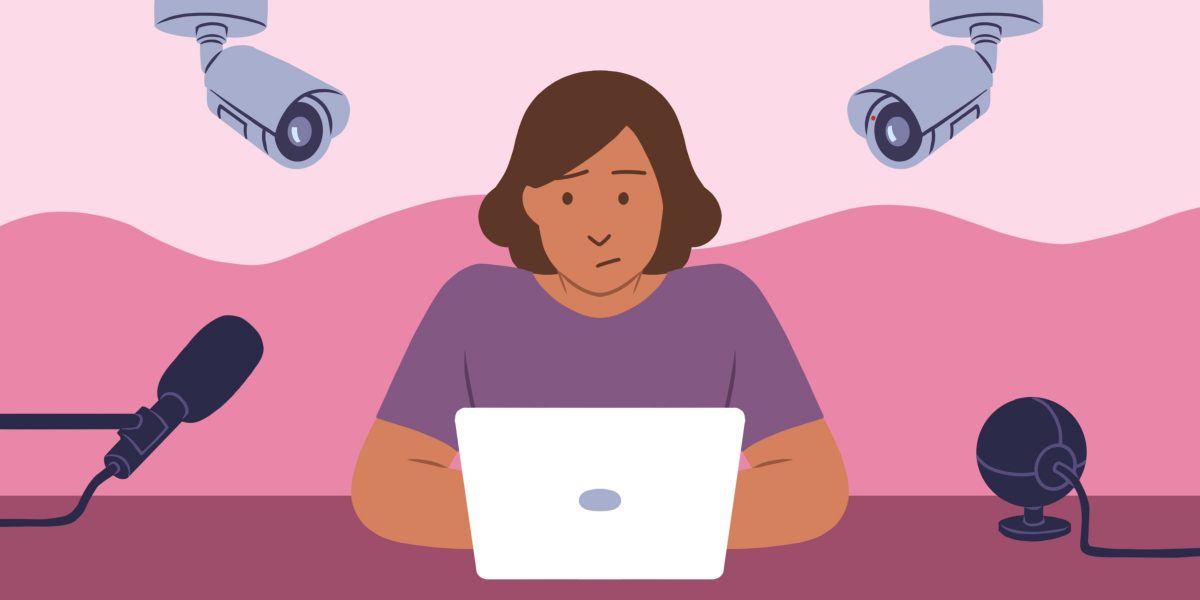By Paige Skinner
The COVID-19 pandemic came along with several unprecedented changes, including a large-scale transition towards employees working from home. Employees being in the office was no longer viable for many employers, so they moved to a remote work format.[1] With this move came the question of how productive employees could be without the built-in supervision of working from the office. Due to this concern, many employers looked for ways to track employee productivity.[2] They found an answer in software that could be downloaded onto employee devices, such as InterGuard and ActivTrak.[3] InterGuard allows employers to track employee activity through their location, how much time they spend idly on their devices, their perceived level of productivity, and can also secure employer data if the employee is terminated.[4] ActivTrak is similar in that it can provide information on employee behavior, determine how efficient an employee is being, and can help employees set goals and configure their workload balance.[5] These are just two of the numerous programs that employers can use to track their employees while they work from home. Employers can use the information they collect from software programs such as InterGuard and ActivTrak in several ways, including to secure the company’s data and assist them in making personnel decisions.[6]
Many employees may not even be aware that their employers have installed productivity tracking software on their work computers, phones, or tablets.[7] However, those who are aware have expressed concern over their employers tracking them this way.[8] Many argue that installing this technology feels like an invasion of their privacy.[9] These concerns, naturally, raise a question of the legality of software programs like InterGuard and ActivTrak. Concerned employees may be happy to learn that there is legislation that aims to protect them in these situations. The main statute that governs how employers may track their employees at home is the Electronic Communications Privacy Act (ECPA) of 1986.[10] The ECPA allows employers to “monitor employees in the workplace, including both written and verbal communications, for any legitimate business purpose” and can utilize other methods of monitoring if they receive employee consent.[11] A legitimate business purpose means anything that is in furtherance of the employer’s business or mission.[12] This purpose can look like an employer obtaining video footage, monitoring calls made through company phones, or tracking internet usage to ensure productivity.[13] A logical inference can be made that ensuring employee productivity is in direct correlation with a legitimate business purpose, as a business cannot be successful without productive employees. Because employers can easily link tracking employee productivity to furthering their business interests, it appears as though many of the lengths they go to track employees from their homes are, in fact, legal.[14] While this may seem like an invasion of privacy from an employee’s perspective, it is seen as a necessary tool for employers.[15] One employer went as far as claiming they believed “economic ruin” was in store for his company if his employees turned to remote work, and therefore tracking employee productivity was essential to prevent failure.[16]
As technology advances and remote work continues to become the norm post mandatory COVID-19 pandemic restrictions, productivity tracking software will likely continue to soar in popularity.[17] As the technology becomes more refined, employers should make it their priority to be in compliance with the ECPA and maintain transparency with their employees to ensure not only employee productivity but also employee morale.
[1] Tatum Hunter, Here are all the ways your boss can legally monitor you, The Washington Post (Sep. 24, 2021, 7:01 AM), https://www.washingtonpost.com/technology/2021/08/20/work-from-home-computer-monitoring/.
[2] Id.
[3] Skye Schooley, 5 Tools for Tracking Your Remote Staff’s Productivity, Business.com (Sep. 20, 2022), https://www.business.com/articles/11-tools-for-tracking-your-remote-staffs-productivity/.
[4] Id.
[5] Id.
[6] See id.
[7] Lindsay Lowe, What is ‘tattleware’? How employers may be tracking you at home, Today (Feb. 23, 2022, 9:12 AM), https://www.today.com/news/news/can-companies-track-workers-from-home-what-to-know-rcna17316.
[8] Id.
[9] Id.
[10] David C. Wells, Legal Considerations When Monitoring Remote Employees, EmploymentLawFirms, https://www.employmentlawfirms.com/resources/remote-employee-monitoring-laws.html#:~:text=At%20the%20federal%20level%2C%20the,for%20any%20legitimate%20business%20purpose (last visited Sep. 23, 2022).
[11] Id.
[12] See Managing Workplace Monitoring and Surveillance, SHRM, https://www.shrm.org/resourcesandtools/tools-and-samples/toolkits/pages/workplaceprivacy.aspx (last visited Sep. 23, 2022).
[13] Id.
[14] Wells, supra note 10.
[15] See Hunter, supra note 1.
[16] Id.
[17] Lowe, supra note 7.

Image Source: https://neuroleadership.com/your-brain-at-work/stop-the-surveillance